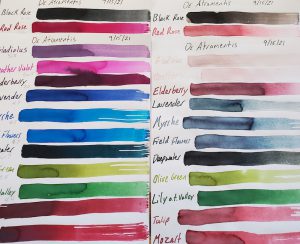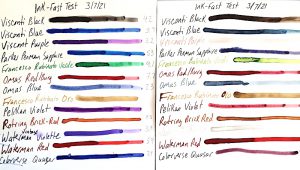Happy New Year! Let’s start the year right with a fresh look at some lesser known inks.
De Atramentis is the Latin word for ink. The company is based in Germany. It specializes in a series of specialty inks, including perfumed inks. We obtained 13 colors from a collection and decided to test them with 6 months of UV light. We also tested their pH level.

Here are the results of our UV light testing of De Atramentis inks. The left side is unexposed to UV light. The right side was in a sunny window for about 6 months.
The inks we tested were Black Rose, Red Rose, Gladiolus, Heather Violet, Elderberry, Lavender, Myrrhe, Field Flowers, Deepwater, Olive Green, Lily of the Valley, Tulip and Mozart.
Straight out of the bottle, I love the rich, vibrant, saturated colors of the inks. A blue-ink addict, I especially love the Myrrhe and Field Flowers. Lavender is lovely but it is a deep blue, not purple, as I would expect. Deepwater is a blue-black. Lily of the Valley stands out as a very pretty green, to me. Red Rose shades from reddish purple to a nice pinky-purple, fuchsia, maybe.
Click the photo for a close-up look at the DeAtramentis inks.
After spending most of autumn and winter in my sunniest window, the results surprised me. You can see the results in the photo, but there was a unique unevenness to how the colors handled the UV light. Most of them lost their special vibrant saturation. It always surprises me when black inks such as Black Rose fade a bit. Red rose took a hit but didn’t completely fade out the way Gladiolus and Heather Violet did. The deep, rich purple of Elderberry faded substantially but still held on. Lavendar, Myrrhe and Field Flowers faded heavily to what basically is the same color! Deepwater lost its blue to become more of a black. Yet Olive Green and Lily of the Valley didn’t lose much of their color or vibrancy at all! Tulip and Mozart seemed to have lost about half of their original color.
Vibrant and saturated colors often fare poorly on pH tests, as they are usually quite acidic or base/alkali. In our testing, the results were fairly pH neutral for these inks. As a brief reminder, pH neutral is 7 on the scale of 0 to 14. Pure distilled water is a 7. O is acidic and 14 is alkali or base. In theory, we want our inks as close to 7 as we can get them. BUT, it is important to note that we have no idea how the ingredients in these inks will interact with the rubber ink sacs, celluloid and elements of your converters. A 7 pH with ingredients that might cause some sort of chemical reaction with a rubber ink sac might be disastrous for a pen. Therefore, this is simply raw data that I hope you find interesting.
Black Rose………………….6.6
Red Rose…………………….6.6
Gladiolus…………………….5.8
Heather Violet…………….6.5
Elderberry…………………..7.0
Lavender…………………….4.7
Myrrhe……………………….4.5
Field Flowers………………4.7
Deepwater………………….6.8
Olive Green…………………7.4
Lily of the Valley…………4.4
Tulip………………………….6.0
Mozart……………………….5.4


 Shopping Cart
Shopping Cart





